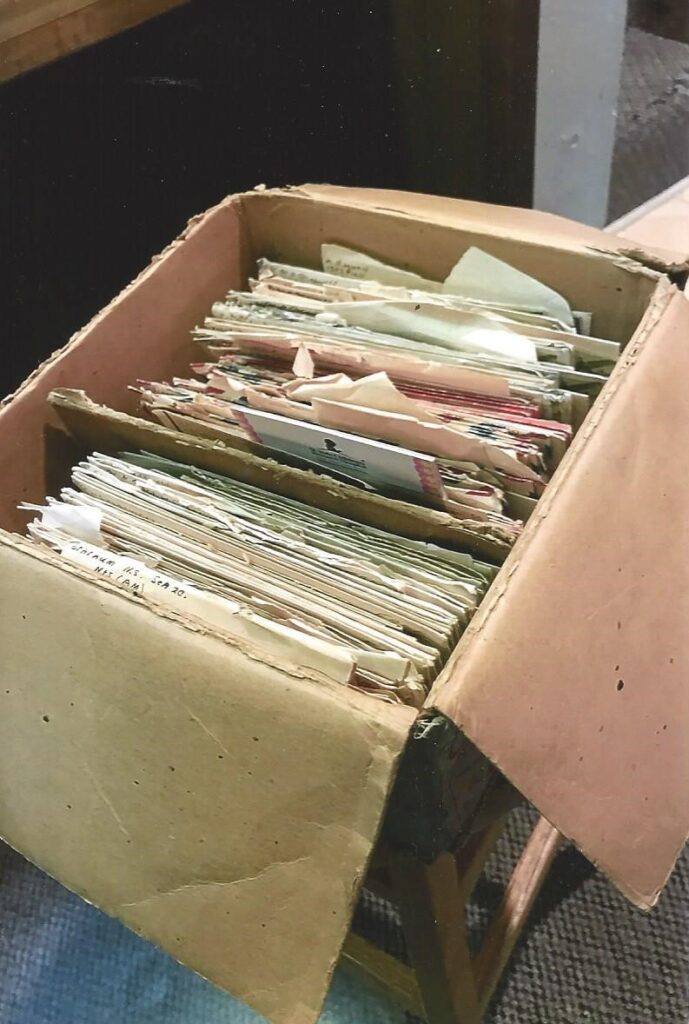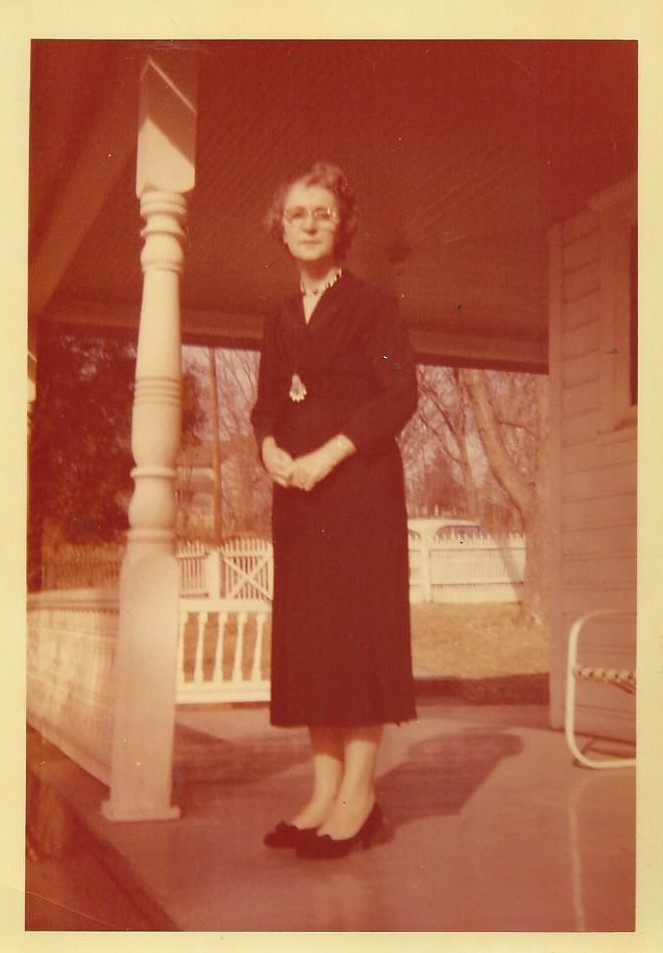The Box of Letters
The box of letters sat in a corner of our dining room for almost a year. There was nothing special about the box. The top flaps were folded crisscross to seal in the contents. It was a plain, old box made of brown cardboard. It was small, square in shape measuring 9 1/2 inches and was 5 ¼ inches tall. The box had many labels on it. Originally, the box had been used to ship a partial order of some item from Montgomery Ward in Chicago, Illinois. The items had been shipped to my wife’s grandfather G. D. Maxwell. It was the third box of a shipment. Other labels on the box warned that the contents were FRAGILE *LIQUID* THIS SIDE UP MORE THAN ONE PINT IN GLASS — OR – ONE GALLON OR MORE IN CANS GLASS KEEP AWAY FROM Fire, Stoves, Radiators, Lighted Matches, Lanterns and Direct Sunlight CAUTION LEAKING PACKAGES MUST BE REMOVED T0 A SAFE PLACE DO NOT DROP etc. The labels were on one side and carried over to the bottom of the box. There was a FOR VICTORY SAVE and SELL shield marked on the bottom. The cancellation mark on the two stamps shows the box had been mailed in March 1944. But no one had read any of this until long after.
No one may have read the outside, but everyone in the family had a good idea what was contained on the inside – letters. Letters written by my wife’s dad – Winfred G. Maxwell – to his parents, the ‘Dear Folks’ during the war.
The box arrived at our home in Shawnee, Kansas after my mother-in-law – Pat Maxwell – passed away in 2016. She had been Winfred’s wife since they were married shortly after the war. Winfred had passed away many years earlier, in 1987, a victim of cancer.
Pat lived alone after Winfred’s death in their small suburban home in St. Ann, Missouri. This is where they had raised their three children – Terry, Sue and Gary – and helped to raise their six grandkids – Terri Sue, Doug, Gary Jr., Andy, Scott and Stacy.
Winfred and Pat’s house had been one of the many tract homes built quickly after the war for the returning troops and their growing families. When new it had 2 and ½ bedrooms, one bath, a small living room, and an even smaller kitchen/dining area. After the kids had grown and moved away, a large family room was added, and my wife’s small bedroom became the new kitchen. A two-car garage was out back. The house had no basement, but it had an attic. This is where the box had been found.
How the box got there, no one remembers. Obviously, it had to have been moved there from Guy and Cressie’s house in Irondale, Missouri. That is where Winfred’s parents had lived. There they raised their four children – Margaret, Winfred, Clifford and Patsy.
The Maxwell house in Irondale was one of the biggest in the town. It was three stories tall with a wrap-around porch, located up the hill two blocks east of the town’s main street on the southeast corner of Maple Street and Cherry. Across the street was the Baptist Church; next door was the Methodist Church.
For decades, Winfred’s dad, Guyton Dent Maxwell had served as the postmaster for the town of about 400. He was a good man and was well respected. He could recite poetry from memory and marveled that as a child, my wife, loved to drink butter milk. He was an active member in the Irondale Baptist Church and at times would lead worship in his deep baritone voice. He would also help when needed at the Methodist Church next door where he would sometimes be asked to give a sermon. He was a giving man, having donated the property across the street from their home for the grounds of the new church. He was known by many for his ‘artistic penmanship’. He often made the high school graduates’ diplomas by hand and frequently gave his artwork away to friends and family members. He was a good husband, father, and grandfather.
Guy and his wife – Cressie – were married for 55 years. Cressie was a good Christian wife and mother; devoted to her family, friends and church.
When the box was first opened, we were amazed by the number of letters it contained. The letters in the box were written to Guy and Cressie. After randomly selecting a few to read, the story of a young man that none of us had ever known was revealed. The letters tell the story Winfred, their son, had wanted his parents to know. A story that must have been common for the hundreds of thousands of young men and women that had served our country during one of the most difficult struggles in our nation’s history. and the world’s. We knew then the contents of the box must be saved and shared.
The box contained one hundred forty-seven letters, a pay stub and a Christmas card. Almost all were addressed to G. D. Maxwell Irondale Missouri. They began with “Dear Folks” and ended “As Ever Winfred”. A few letters had been sent to his younger sister Pat. A few others had been sent to him by his friend Bob Merrill. Bob was a first cousin to Winfred’s future wife Pat.
The letters were arranged in chronological order. The oldest item in the box was a pay stub from the McDonnell Corp for which Winfred had briefly worked before his years in the service. The second oldest was a Christmas card Winfred had received in 1942 from a high school friend that was already serving in the Navy.
Winfred was drafted in 1942. He enlisted in the Army Air Force and reported to Jefferson Barracks in South St. Louis, MO on December 22. The letters began arriving home after that. The first post card is dated Jan. 19, 1943; the last letter was sent in June 1945. For the first year of his training/service – 1943, Winfred was stationed at various bases throughout the country. It was quite a change for a young man from a small town in Missouri who had never traveled far from home. Before this time, the largest city he had ever seen was St. Louis, Mo. By the end of 1943, he had travelled from coast to coast. He trained to be a radio operator, met his crew, received the rank of tech sergeant, was assigned to a new B-24H – Liberator – the “Hoo Jive”, and was ready to ‘go over’. In January of 1944, he and his crew flew to England as part of the 8th Army Air Force. Their first combat mission was on February 15th. Their last combat mission was on June 25th. They completed twenty-nine missions in all and were finished in Europe. All had survived. The crew was broken up in July. Winfred returned to the States, received additional training and served in the Army’s -A ir Transport Command (ATC) – in the Pacific as a radio operator on a C-54 transport plane until the war’s end.
In total, over 300 letters have been found. In addition to the one hundred and forty-seven postcards and letters Winfred had sent to his parents, he had also sent his older sister- Margaret- another ninety-four. Margaret had lived in St. Louis during the war. My wife’s brother had inherited them. Plus, Winfred’s younger brother – Clifford – served in the army. He was first stationed in the Puget Sound Harbor Defense. He then served in Europe in a mobile artillery unit until the war’s end and stayed on after the war to help bring stability to the devastated continent. Clifford sent sixty-five letters/V-Mails home to his parents. My wife’s cousins have graciously shared them with us.
In addition to these letters, Winfred had kept a small leather-bound journal in which he recorded notes after each of their 29 missions. We first heard of the journal back in 1980 when the crew gathered in Florida for an 8th Air Force reunion celebrating 35 years since the war’s end. Though they all kept in touch through the years, this was the only time the entire crew reunited. After Winfred’s death, mom showed us the journal for the first time. The contrast between his letters home and the reality of the actual events as they occurred is enlightening.
Winfred never spoke of the war to any of his children.
All of these letters will be posted in real-time on the day they were postmarked 80 years ago. They will be posted at ‘maxwellslettershome.com’. Subscribe to receive notification when new letters are posted. You can also follow along on Facebook. Just friend ‘Winfred Maxwell’.
Countless stories, books and films have been collected, written and made concerning the sacrifices made by this ‘Greatest Generation’. These letters are only a drop in the bucket. What they show is the life of typical small town young man, his training and experiences as an airman in the greatest conflict in human history. These letters reveal what he wanted his parents to know and what he was allowed to share. They show his longing to stay in touch with those he knew, those that cared about him, and his concern for them. News of the events happening overseas, the rumors, the facts, the fears, the battles and stories were rampant. These letters show the daily life of a young man growing up during an extraordinary time.
Let the letters speak for themselves. Read the letters as though you were the parents of this young man, as a family member, or as a friend.
His life and the world was changed forever and so was ours.
Jim and Sue (Maxwell) Benz
P.S. We have done the best we could trying to read and reproduce these letters in text form. Copies of the original letters/envelopes will also be posted. If you notice any needed corrections, have any additional information, or can explain some of the vocabulary, please let us know.
Email your comments to ‘[email protected]’.

